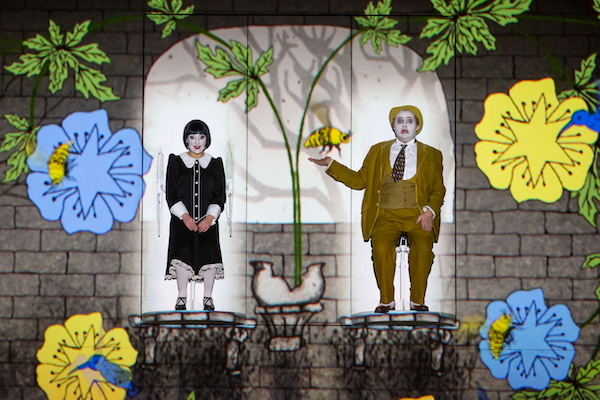Singers provide moments of vocal artistry in HGO’s machine-like “Magic Flute”

No one can accuse stage director Barrie Kosky of being stuck in a rut. His production of Mozart’s The Magic Flute, which Houston Grand Opera brought to Wortham Theater Center on Friday, could hardly be more different from his take on Saul, presented by HGO in 2019.
Kosky’s Handel staging may have set a record for visual austerity. it at times unfolded on a set consisting only of an expanse of soil—represented by tiny rubber pellets—blanketing the stage. At one point, the distraught Saul, clad in nothing more than boxer shorts, ran in a circle across this scorched-earth vista.
Magic Flute, conversely, is a kaleidoscope of imagery. Created in collaboration with 1927, a London theater company that specializes in blending live action and animation, Kosky’s Flute envelops Prince Tamino, his sidekick Papageno and the rest of Mozart’s mythical characters in a constantly evolving panoply of video images.
At times, the images fill the stage with a fantasy-realism substitute for three-dimensional sets. Characters land in a dragon’s stomach, stride along rooftops or descend into the bowels of the earth.
There’s no three-dimensional set at all, unless you count the white wall—noticeable only during blackouts between scenes—that serves as the screen for the projections. Sections of it flip around to let characters perch high above the stage, with the animated images filling in around them: When Pamina, Tamino’s would-be sweetheart, despairs to the point of suicide, Kosky and his co-creators—co-director Suzanne Andrade and animation designer Paul Barritt, both of 1927—ratchet up the tension by placing her on a mountain precipice as she brandishes a dagger. Will she not only stab herself, but jump?
Other times, the animation abandons any semblance of the real world and takes off into whimsy and pure fantasy.
When characters imagine love blossoming, flowers sprout everywhere. After Pagageno overindulges in liquor, he floats through space amid a herd of pink elephants; when he finally meets his Papagena and they imagine children, a home appears around them and youngsters pop up to frolic in it. As Tamino and Pamina, united at last, undergo the climactic trial by water, they’re surrounded by jellyfish, sea horses and the like.
Kosky and company—including revival director Erik Friedman, who staged Flute for HGO—sidestep the opera’s traditional Egyptian and Masonic trappings to go deeper into fantasy.
The eponymous magic flute takes the form of an animated dragonfly-woman who wafts around spouting a musical staff and notes. The Queen of the Night is a giant spider whose legs surround Tamino as she implores him to track down Pamina, her daughter. Monostatos harkens back to the 1920s silent-movie vampire Nosferatu with his hairless, stark-white head and narrow black coat.
That isn’t the production’s biggest nod to silent movies. The staging jettisons the spoken dialogues between Flute’s musical numbers, converting it into projected intertitles like the ones movies used before sound came along.
Which leads us to the production’s weakness. Yes, the animation’s visual cornucopia delivers many moments of charm and drama. But it sometimes reduces the flesh-and-blood cast to being mere cogs in a giant image machine.
The ejection of the dialogue episodes obviously cuts out a big part of the cast members’ opportunity to bring their characters to life. And especially when they are clamped onto the little platforms sticking out of the video wall, they’re locked in place as they sing, with the animation supplying not only scenery but, sometimes, much of their bodies.
On Friday, some singers were better able than others to give their characters profiles of their own.
The staging put tenor Norman Reinhardt’s Tamino in the most difficult spot: He often had to stand frozen with his arms down by his sides. That was hardly conducive to cutting a heroic, steadfast figure. But Reinhardt sang with a ringing, generous tone that helped flesh out the character in sound. Admittedly, Reinhardt showed effort at times in the higher stretches of“Dies bildnis,” and his tribute to the nonexistent flute, “Wie stark ist nicht dein Zauberton.” But if others have sung those more deftly, he brought them a red-bloodedness that put across Tamino’s ardor.
Papageno, Tamino’s sidekick, had more opportunity to move around, and baritone Thomas Glass took advantage of that to create the liveliest character onstage. Glass captured Papageno’s joviality not only through his buoyant demeanor, but through the mellowness and bounce he gave the arias—especially the breezy “Ein Mädchen oder Weibchen.” But when Papageno despaired of ever finding his Papagena, Glass played the scene straighter than some baritones do.
The staging gave soprano Andrea Carroll’s Pamina more chance to be spirited and engaging when she was in Papageno’s company than in Tamino’s. Carroll enhanced those compelling moments with the warmth and lyricism that by and large dominated her singing. She brought particular poise to Pamina’s cozy duet with Papageno, “Bei Männern.” The first part of “Ach! ich fühl’s,” flowed out less smoothly, but Carroll spun out the final phrases in a veiled tone that at last made contact with the music’s pathos.
Soprano Rainelle Krause may have been the most physically circumscribed of all as she portrayed the arachnid Queen of the Night. Nothing was visible of Krause except her head; the animation supplied the rest of the immense spider. But Krause blazed through the Queen’s two arias with a brilliance, agility and precision that outshone even the video projections.
Bass Anthony Robin Schneider also was locked in place for the bulk of his time playing Sarastro, and that kept him from giving much visual semblance of the priest’s dignity and nobility. The resonance and breadth of Schneider’s singing helped tell the story, though, and Schneider treated the music’s lower reaches to a sturdier tone than some basses can muster.
Tenor Aaron Pegram sang with an eagerness that pointed up Monostatos’s sexual desire for Pamina, but his vampirish appearance did even more to capture Monostatos’ creepiness. At the other end of the charm spectrum, soprano Raven McMillon made a bubbly Papagena.
As the Three Ladies, Caitlyn Lynch, Sun-Ly Pierce and Taylor Raven didn’t always blend vocally, but they brought attitude galore to the women’s posturing. Alexis Medina, Ella Clark Theurer and Liam Norton sang gently as the Three Spirits; maybe that was only to be expected, since the animation turned them into little moths.
The Houston Grand Opera Orchestra, led by conductor Jane Glover, brought out the score’s zip, charm and quasi-religous spaciousness with equal style.
Glover also had a knack for accentuating key moments for the singers: She gave Carroll time to linger over one of the high B-flats in Bei Männern,” and she waited a split-second to set up Schneider for the final, most majestic phrases of “O Isis und Osiris.” As attention-grabbing as all the animation was, Glover helped ensure that Mozart still got his word in.
Houston Grand Opera’s The Magic Flute runs through Feb. 13. houstongrandopera.org
